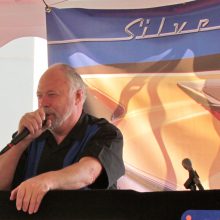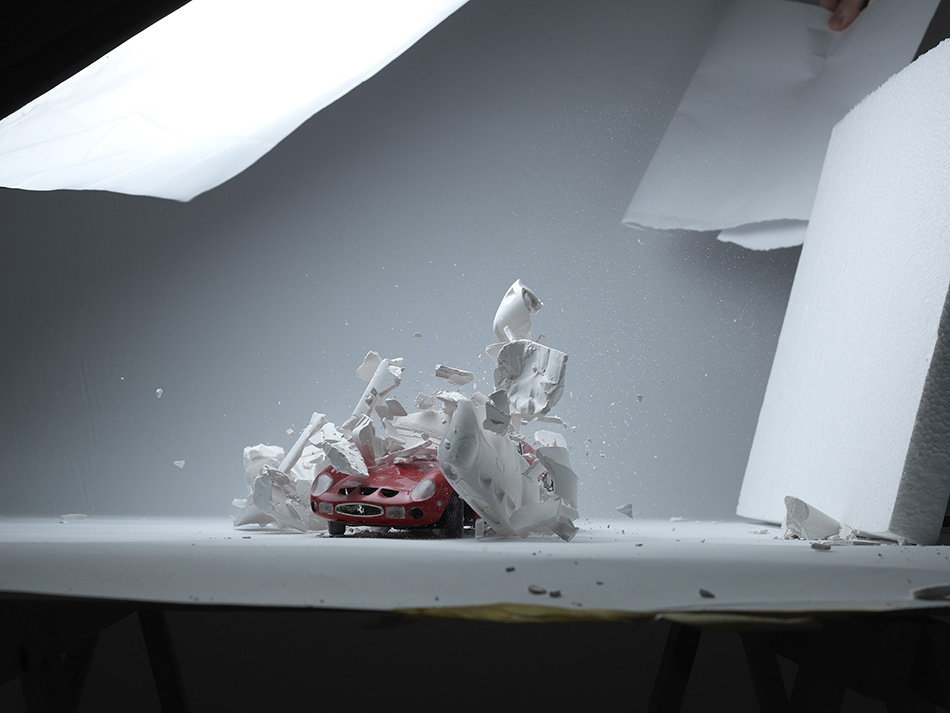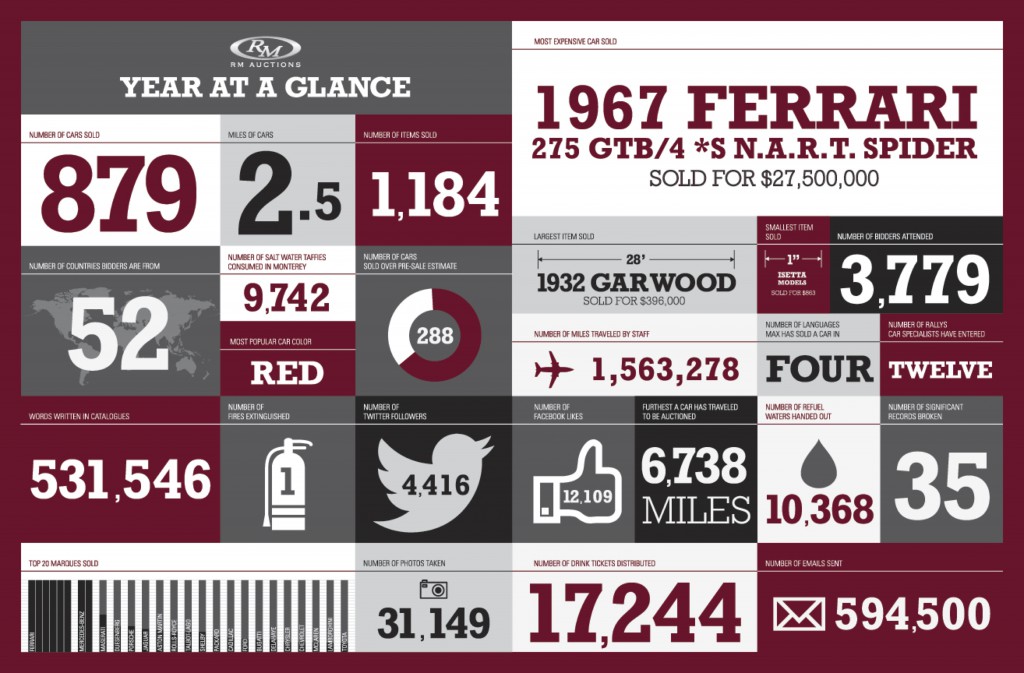
The 1963 Ford Thunderbird, white with a brilliant red and metal flaked roof, caught my eye. After all, how can you not like a Bullet ‘Bird?
And then I noticed the car parked next to it. It was a 1964 Ford Ranchero, and it was painted in the same colors. Actually, it looked like the paint may have come from the same cans.
The tag in the windshield said the owner of the Tbird was Shane Stratton. The paperwork in the Ranchero’s window said it was owned by Tyler Stratton.
Turns out that Shane and Tyler are father and 18-year-old son.
Shane said he’s been working on his Thunderbird for eight years, but he says he is only 60 percent of the way finished with its restoration and customization. Still to come: air suspension, the interior restoration, repainting of the fenders, hood, decklid and doors, and one more round of wet sanding and a final coat on that gorgeous top.
Tyler’s car is much closer to completion, basically awaiting a new grille and all sorts of rubber components.
The Strattons’ cars were among some 500 parked recently just south of Phoenix at the Wild Horse Motorsports Park (formerly Firebird Raceway) for the third annual Rockabilly Bash.
The bash is sponsored by the 5 & Diner restaurant group. Two hundred cars showed up for the inaugural event. Last year there were 360. This year 500 were on display and organizers already are planning on a thousand for the first Saturday of 2015.
The showfield was full of hot rods, rat rods, American classics and even the occasional foreign car, all of them in various states of deterioration and restoration. But that’s the beauty of the Rockabilly Bash — well, that and the live music and the 1940s-style pin-up beauty queen competition.
The Bash isn’t for exotics or concours-quality cars. Instead, it’s a display of automotive artwork in progress, mechanical mayhem, and good ol’ grassroots classic car fun. It’s sort of a car-show version of run what you brung, with everything from cars that look as if they just rolled off a 1950s showroom to those that look like, well, like combinations of parts and panels you might not see anywhere else, or never expected to see in the first place.
Consider a 1946 Ford pickup truck with the nose from a 1951 Studebaker; a 1955 Ford Thunderbird with green, matte-finished paint and white steel wheels; or a 1934 Pontiac with its sedan top and hood painted gray over a yellow shoulder stripe and maroon lower body and fenders, all riding on green wheels.
Patina counts with this crowd, but so does everything from matte primer to expertly applied custom-colored metal-flake. And flames. And pinstriping.
Many of the cars and trucks appear to be the result more of someone’s whimsy, far removed from some automaker’s design studio or assembly plant.
These cars are more than the sum of their parts. In simple terms, they are what they are, and we appreciate them — and their owners — for that very fact.


















Finally! ‘Reality’ TV promises to get real about classic cars as Corky hits the backroads
Like me, are you appalled, even downright angry about the way television portrays the classic car hobby?
Click on your big screen and start surfing the channels and before long what you’ll see is someone buying a classic car as cheaply as possible, hauling it back to their shop, slapping on some paint, doing minimal mechanical and interior work, and then flipping the thing with one goal in mind — maximized profit.
Sure, everyone likes to make a profit when they sell something. But the classic car hobbyists I know are in this because they love the cars — and the search for the cars — and they love restoring and even maintaining them, getting them running again and looking great. For the most part, they sell them with a degree of reluctance, often only so they can begin the pursuit of their next project.
The find-fix-flip format we see on so many of the classic car “reality” television programs is the polar opposite of what I see when I look at the classic car hobby. I get more than irritated when I see such shows, and I rarely watch them for more than a few minutes.
But that will change very soon, because I plan to tune in for the debut of Backroad Gold, Corky Coker’s new show.
From what Corky has shared with me, his show sounds like the classic car version of American Pickers, which is less about buying and selling than it is about educating us to America’s antiques and introducing us to the characters who have been caretakers to artifacts of our historic heritage.
Backroad Gold debuts February 5 — and then runs for at least eight more episodes — on the Travel channel. The program follows Coker and company as they search for cars, motorcycles, old gasoline pumps, road signs and such.
Why am I optimistic about Backroad Gold? Because of Corky, who is about as genuine a classic car hobbyist as you’re ever likely to find. Oh, sure, he’s also part of what I call the classic car industry, the auction houses, insurers, transportation providers and parts producers who supply the things that classic car hobbyists need and buy to pursue the hobby. In Corky’s case, those things are Coker Tires, tires that offer the look of vintage rubber but that also provide the safety and engineering advances of modern tire technology.
But that’s just Corky’s day job. His passion is finding, restoring and driving old cars and motorcycles, and being an evangelist for the hobby.
When The Great Race, the annual cross-country rally for classic cars, appeared to be faltering, Corky bought it, pumped it up and put it back on solid footing. He resurrected the famed Honest Charley Speed Shop & Garage. He helped launch the Collectors Foundation that supports car restoration education in high schools and colleges.
“I grew up in the back seat of a 1910 REO,” he says of riding along with his mom and dad on the old Glidden Tours.
On the new television show, Corky hits the backroads in pursuit of more than just neglected classics. Corky is a car guy, but also a people person, and part of his mission is to introduce the world to what he calls the real Americans.
“The real people of America are on the backroads,” he said, sharing just one example we’ll see on the show — twin 78-year-old brothers who have protected a V12-powered 1934 Pierce-Arrow sedan in their dairy barn for more than 40 years.
As for the cars he finds and is able to buy, “We’re able to restore them and put them back into play,” he said.
The “we” he mentions includes Corky; his father, Harold; his daughter, Casey; her husband, Greg; and Hal, the “head wrench” back in the shop.
Casey said that throughout her life, her dad has been “bringing home all this weird crap.
“I see labor and man hours and cost,” she added. “He sees a jewel.”
Corky’s personality isn’t the only thing that promises to separate his show from the others. For one thing, he’s playing with his own money, not with funding provided by a television production company. For another, instead of flipping the cars once they’re restored, Corky’s tendency, and perhaps his lament, is to keep them because parting with them would be painful.
As I said, this is a real car guy.